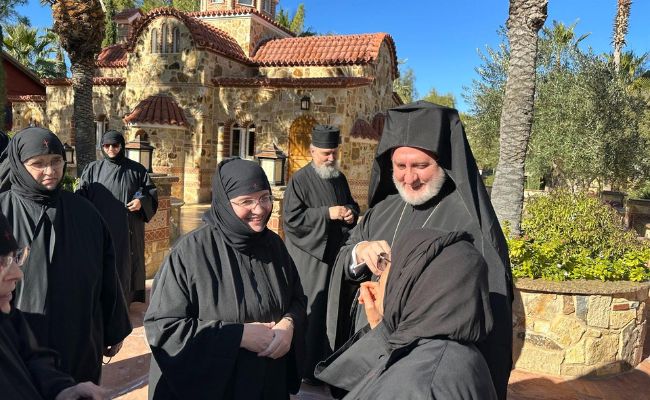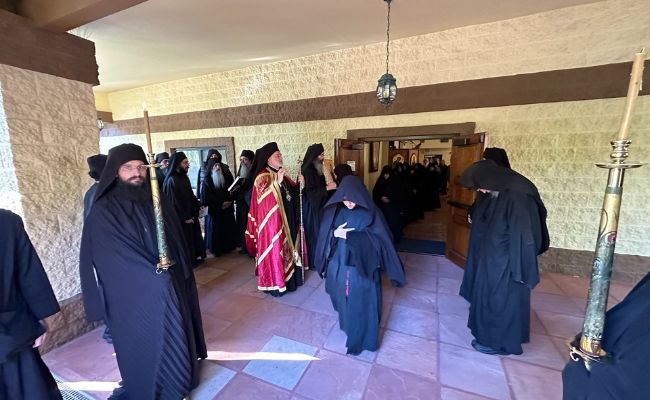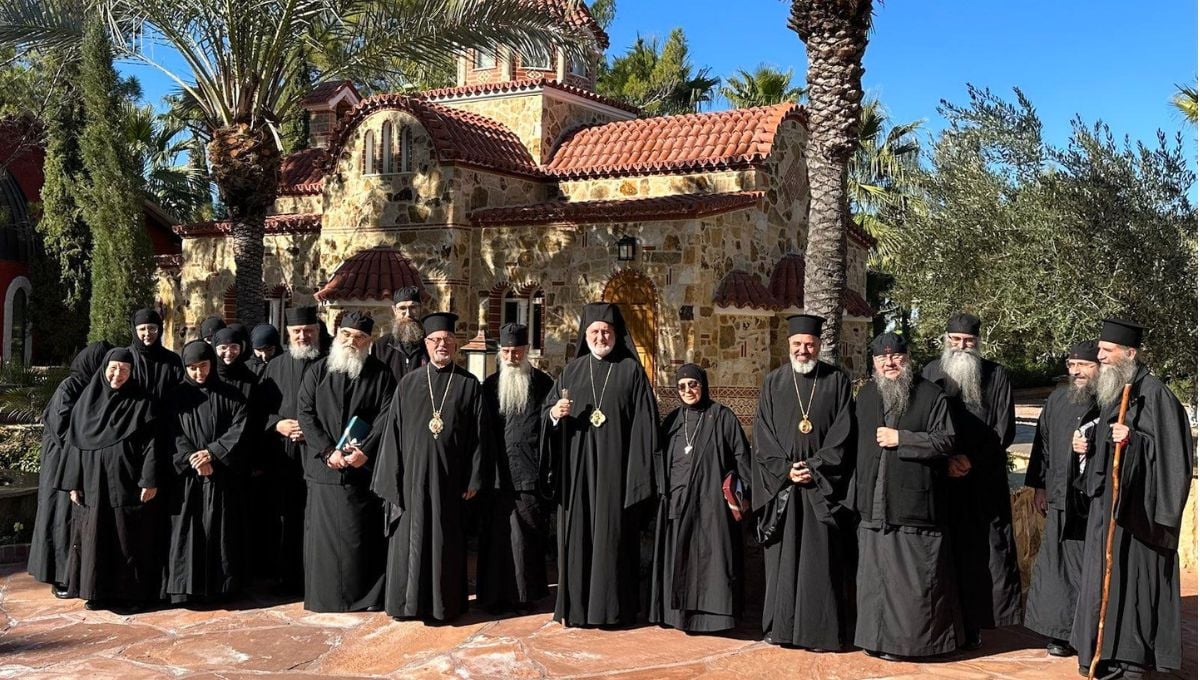Greek Orthodox Archdiocese of America
Second Monastic Synaxis
Address by His Eminence Archbishop Elpidophoros of America
St. Anthony’s Greek Orthodox Monastery (Florence, Arizona)
December 17, 2022
Your Graces,
Reverend Fathers and Mothers,
Without question, monasticism forms part of an ancient tradition within the Church. The monastic tradition embodies a well-defined and constant orientation and purpose. Regardless of whatever organizational features it assumed throughout history, monasticism remains in its essence unchanged. Inextricably linked to the historical evolution of the Church of Christ, monasticism provides a stable spiritual foundation of the Church’s engagement in the world, often acting as a counterweight to secularizing tendencies or doctrinal digressions. At the same time, monasticism presents an important witness and reminder of the true destiny of humankind, which is to be sanctified in Christ.
Monasticism is deeply rooted in the fellowship and unity as between Christ and His Apostles. Leaving everything behind, monks follow Jesus on the Cross and the Resurrection. Having nothing yet possessing all things. Not belonging to the age ruled by the deceiver but projecting their lives to the age and Kingdom which is to come. Gladly accepting to share in the suffering, the hardship, the sorrows, and insecurities of their fellow human beings. With their ascetic life and prayer, they take up the countless crosses borne by others, in the fullest expression of hope in the coming Lord.
As genuine custodians and guardians of the authentic Church tradition, monasticism has, over the centuries, invaluably contributed to the spiritual regeneration of the practicing Christian. Monks and nuns have been both practical and meticulous theologians, striving to heal first themselves through their own sacrifice and repentance, prayerful watchfulness, the unremitting remembrance of death, divine illumination and theosis (deification) by grace. Walking the path of renunciation, which consists in the continuous renunciation of the world, the hindering of one’s own will, and the abandonment of every form of vainglory, monastics take up the cross of mourning, of the inner struggle with passions and desires, and of the complete and self-emptying surrender to the will of God, culminating in the final and eternal union with Him.
With the cleansing of the heart, the illumination of the nous (the intellect) and theosis, monks and nuns relentlessly participate in the Crucifixion and Resurrection of the Lord, and are spiritually deified as a result. Savoring the experience of loving communion with Christ and the watchful knowledge of God, the holy monastics provide signposts for fallen humanity. Within the monk and nun, the Gospel is being realized, and so the light of the Word of God as experienced by them shines in the world. As St. John of the Ladder says, “[a]ngels are a light for monks, and the monastic life is a light for all men.”
The late Very Rev. Fr. Georgios Kapsanis very aptly explains: “locally isolated and silent, but spiritually and secretly in the midst of the Church and from a high pulpit, the monk preaches the statutes of the Almighty and the need for an absolute Christian life.” The humble monk, becoming by the Grace of God a vessel of the Divine Grace, radiates this Grace “that all may see, repent, believe, be comforted, rejoice in the Lord, and glorify the Merciful God.”
This contribution of monasticism to the world essentially exemplifies the significant and salvific value of the presence of our holy monasteries throughout America. The sapling of monasticism, which was planted in the desert of Egypt, was watered with the sweat of the monks of Palestine and Syria, further developing in the Stoudion in the Queen of Cities (Constantinople), flourishing on Mount Olympus in Bithynia (Asia Minor) and bearing so much fruit on Mount Athos, blossoms today in America.
We savor the sweet fruits and blessings of this ancient tradition. With a burning desire for love and an intense longing for ascetism in their hearts, the world was sanctified and transformed through the efforts of Saint Anthony, Saint Savvas, Saint Theodore, Saint Athanasius, Saint Joseph the Hesychast, and our beloved Elder Ephraim.
Saint Silouan the Athonite writes that: “People think that monks are a useless group. But they are wrong to think so. They do not realize that the monk prays for the whole world. They do not see his prayers and do not know how mercifully the Lord receives them. The monks engage in a great battle against the passions, and for these efforts they will be deemed great before God.”
Beloved Fathers and Mothers, the hesychastic tradition that you convey to the world can bring the peace of sacred stillness to the hearts and lives of our faithful. You are called, monks and nuns alike, to transfigure the world. You are tasked with teaching, healing, and giving rest to the souls of the afflicted and despairing persons who visit our monasteries. You undertake this task with the example of your complete and total dedication to Christ and His Church, your monastic humility, your sacrificial obedience, the fervor of your faith, the fastidious nature of your spiritual life and above all by the grace of your most sacred prayer of the heart. With your night and day laboring, and our own humble and discerning support, our monasteries are and will continue to serve as effective spiritual treatment centers and reliable indicators on the path to holiness.
As I have said in the past and continue to emphasize: “A Church without monastics and monasteries cannot stand. Monasteries have always been, remain and will always be the oases and spiritual shelters of God’s people amidst the desert of our contemporary reality, which is dominated by a secular ethos, the stark departure from Gospel teachings, and an alienation from Christian values and principles. Therefore, our people love and embrace the monasteries and have faithfully supported them throughout the history of the Church.”
Elder Ephraim and his disciples and spiritual children all over the world authentically convey the Orthodox hesychastic tradition of St. Joseph the Hesychast, the brave soldier of Christ who harvested the honey of stillness, emulated the ancient ascetics and became a model of ascetic life and pure prayer. Only as remarkable can we describe the influence of the life and work of St. Joseph on the spiritual revival of Athonite monasticism and on the revival of the philokalic tradition in the Orthodox Church in Greece, Cyprus, Canada, here in America and in the world. Elder Ephraim, laboring in the sacred prayer of the heart with zeal and mindfulness, savored the energies of Divine Grace having lived with St. Joseph the Hesychast. Through his vigilant ascetism and practice of the inner prayer, the Elder developed into a true vessel of the Holy Spirit, and when the fullness of time had arrived, he crossed over to America in order to become a missionary for true hesychasm.
Before the arrival of Elder Ephraim in America, some attempts were made to establish monastic communities, without the desired result. With his ascetic simplicity but full of missionary zeal, with certain knowledge from above concerning the success of this undertaking, our Elder not only transmitted the Orthodox monastic tradition to America and Canada, but founded dozens of monastic communities and, if you allow me to say, sanctified the New World with his prayerful presence. Thousands of souls found comfort under his priestly stole. He was not only concerned with bringing people closer to Christ and the Church, but also with preparing them to battle against the passions and dangers of this age.
Many opposed the Elder, perhaps not knowing enough about the spiritual value of monasticism and not realizing the dynamic potential of monastic life. The Elder however, through unparalleled efforts, pain and tears, with exemplary patience, and above all with evangelical love and forgiveness in his heart, was able to convince even the most doubtful skeptics, becoming an example and light in the darkness of spiritual ignorance. He emptied himself in order to impart to all of us a safer and easier-to-tread path towards salvation.
For the way to salvation, we look to monastic spirituality and its authentically-lived liturgical tradition. As the main purpose of monasticism, the life of daily repentance and prayer underlines an undeniable eschatological dimension. “For here we have no continuing city, but we seek the one to come” (Hebrews 13:14). The value of spirituality that derives from this eschatological dimension of Christlike life is what contemporary America has been longing for.
The lay persons or clergymen who visit the monasteries, full of anguish and questions about their lives and salvation, find answers in the prayer of the monastics. Just by participating in the sacramental life of the monastery, we feel revived and at peace. The outward expression of joyful sorrow on the face of young monks and nuns who left the world behind in pursuit of the Kingdom of God has a remarkable missionary effect, leading the pilgrim, in an almost astonishing manner, to reflect on the futility of the world and to redefine his or her life priorities and values.
The wise counsel of the elder or abbess has the power to repose and soothe the tired soul. Participating in the sacrament of Holy Confession breaks loose the shackles of sin and defeats the attacks of the evil one. Narcissistic and entirely selfish like the Old Adam, the faithful surrender their old selves on the Cross of the New Adam, the Savior Christ. The pilgrims depart the monastery full of grace and spiritually revitalized.
What our faithful experience in the monastery follows them into the world. They return to their families full of love because they have savored the love of Christ, and the love of brothers and sisters in Christ. They now more consciously participate in the life of their parishes, understanding that Christ calls us not just to become good people but also citizens of the Kingdom of God. They understand that the Orthodox faith does not embody an individual religious identity, but a communitarian path to holiness, a holiness which is realized through daily repentance, prayer, and sacramental union with the Bridegroom Christ. The pilgrims experience the Church as the Body of Christ and live with certainty that they are accompanied by the prayer of the monks and nuns. They set goals in their lives to imitate as much as possible the angelic life of the monastics.
In this way, monastic spirituality directly impacts parish spirituality. Our parishes benefit from looking to the example of the common life of the monastics and the integration of more authentic features of the Church’s sacramental and liturgical life. The parishes can continue to apply themselves in the work of salvation in the world, proclaiming the Kingdom of God with renewed fervor. More and more members of our parishes recognize that it is not enough to typically identify as Greek Orthodox, but that they need to become truly active members of the Church. Because of the witness provided by every one of our monasteries, parishioners pray more, they worship more, they confess more, and they commune more consciously. In the words of Elder Charalambοs Dionysiatis, “they do not just celebrate the Resurrection, they live it.” This is the miracle that is taking place in America right now. This is your incredible contribution, reverend Fathers and Mothers, to our Greek Orthodox Archdiocese.
Allow me at this point, before concluding my address, to reveal to you something that I have been thinking about. I believe that it is directly related both to the contemporary turmoil we live with respect the ecclesiastical life and to the way the Elder of blessed memory responded to temptations stemming from ecclesiastical administration. In addition to what I have presented, Elder Ephraim possessed a genuine Church ethos. He was taught by St. Joseph the Hesychast that, notwithstanding various and occasionally unsettling distractions or commotions, “the Church can be found at the Ecumenical Patriarchate of Constantinople.”
Brothers and sisters in Christ, let us always remember that our Ecumenical Patriarchate is our spiritual mother. In the Phanar is the Great Church of Christ and the “Great Monastery.” Our Ecumenical Patriarch is the Great Abbot and he struggles to preserve Orthodoxy and the tradition of the genos (our people) under difficult conditions, while being assailed, persecuted and derided. His All-Holiness our Ecumenical Patriarch Bartholomew is perhaps the only Patriarch in history who with the Holy and Sacred Synod recognized as saints so many contemporary monastics of the Church, revealing to the world that our Church is alive, and that fallen humanity continues to be perfected and that holiness is being realized within the Church. Sometimes, we may regret or even disagree with some of the decisions or actions of our Patriarch. We may think that he makes mistakes. But the Church does not make mistakes. Our Ecumenical Patriarchate is our Church, and the Church is Christ, the same Christ throughout the ages.
Let us, brothers and sisters, follow the example of St. Joseph and our Elder Ephraim, and let us embrace our martyric Phanar. Let us love it, respect it, shelter and protect it. Let us pray for our Patriarch and the members of the Patriarchal Court who struggle daily to provide a precious witness to the faith. Our Ecumenical Patriarchate is the venerable center of Orthodoxy. The Ecumenical Patriarch occupies, in accordance with the decisions of the Ecumenical Councils, the First Throne in the Orthodox Church and has a duty to demonstrate care and concern for all the Churches.
The interest of our Church in general, and of our Archdiocese in particular, is to embrace our monasteries with the love of Christ, and to support them in every way possible and to place them in the center of our life in the Church. I realize that the monastic seeks first and foremost tranquility, but there is a need to come together, to work together in all areas in order to transfigure and sanctify our local Church.
I pledge as Archbishop to do what I can, to do whatever is possible, in order that the peace and love of Christ reigns in all our hearts as One Church, One Body of Christ. All of us together, monasteries and parishes, clergy and lay persons, as one spiritual force, let us stand united to proclaim Christ, Who for us and our salvation was born into the world and wrapped with swaddling clothes. Let us all together, as one family, proclaim the Crucified and Resurrected Lord.
In closing, I want to humbly thank you from the bottom of my heart for honorably standing as loyal custodians of monasticism in America. I ask you to continue your daily witness to the people of God in this country. Please pray for your Archbishop, the least of all His servants. Pray for our hierarchs, our clergy, our faithful, that we may all find salvation, through the intercessions of St. Joseph the Hesychast, whose “sweet-smelling and grace-radiating skull, as a most precious gift and treasure, is preserved in Arizona with joy and gladness.”
Three years ago, our Elder most peacefully feel asleep in the Lord. As we come together for the three-year memorial of this most faithful disciple of St. Joseph and founder of Orthodox monasticism in America, may his memory be eternal and everlasting.
Amen.





